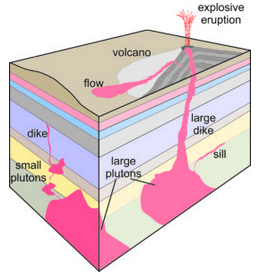6.1: Magmas and Igneous Rocks
- Page ID
- 17539
Igneous rocks and minerals form from magma, molten rock that originates beneath Earth’s surface. Magma often collects in large magma chambers at depth in Earth, but magma is also mobile and can flow through fissures and sometimes reach the surface. Mid-ocean ridges and subduction zones contain most magmas at or near Earth’s surface. Continental rifts and hot spots, places where anomalous heat rises from depth, account for the rest.

Magmas are complex liquids that vary greatly in composition and properties. They have temperatures as great as 1,400 °C and often originate in regions 50 to 200 km deep in Earth. They may be entirely liquid or partially crystalline, containing some crystals of high-temperature minerals such as leucite, olivine, or pyroxene. Within Earth, magma is buoyant and moves upward because it has a lower density than the solid upper mantle and crust. The race between upward movement and cooling (and subsequent crystallization) ultimately determines whether magma becomes an intrusive or extrusive igneous rock.
Magma solidifies as an intrusive rock if it crystallizes before it reaches the surface. Intrusive rocks form plutons (a general term given to any intrusive igneous rock body), so geologists sometimes use the terms intrusive and plutonic interchangeably. Figure 6.2 shows some examples of the most common plutonic rock bodies: plutons, dikes, and sills.

This spectacular photo in Figure 6.3 shows a dike revealed by erosion of surrounding sediments. Shiprock, a peak in northwestern New Mexico, is in the background. The tall jagged peak is what remains of the internal plumbing of a volcano that was once present. The dike was created by the same magma that powered the volcano.
Magmas that form intrusive rock bodies are normally surrounded by very warm rocks, so they cool (and crystallize) slowly, perhaps only 1 to several degrees in 1,000 years. In contrast, magmas that reach the surface cool quickly. They may produce lava flows or erupt explosively into the air, ejecting pyroclastic material (ash and other debris of variable size). The result is sometimes just unconsolidated volcanic debris. Typically, though, eruptions produce extrusive rocks (generally called volcanic rocks although a volcano may not be involved) that from from flows or from pyroclastic material that is lithified (hardens to become rock) as it cools.
Cooling rate directly affects grain size of an igneous rock. The common plutonic rock granite contains crystals of quartz and potassium feldspar that are easily seen with the naked eye. In the photo of granite below (Figure 6.4), the quartz is gray and the feldspar is salmon colored. A common volcanic rock, rhyolite (Figure 6.5) may have the same minerals, but we need a microscope to see the crystals. The rhyolite in Figure 6.5 is pink because it contains small crystals of pink potassium feldspar. It also contains larger crystals of quartz that appear as dark specks in the rock. Crystals in granites have a long time to form and may grow large. In contrast, volcanic rocks, such as rhyolite, crystallize rapidly because extrusion exposes the erupting magma to the cool atmosphere at Earth’s surface. Consequently, any crystals that form are small.



Sometimes extrusive igneous rocks cool so quickly that no crystals form. This is especially likely to happen if lava meets water. The result is a rock composed of volcanic glass called obsidian. Examples of obsidian appeared in Figures 1.21 (Chapter 1) and Figure 4.5 (Chapter 4). In other cases, different minerals may grow to distinctly different sizes. The result may be a porphyry, a rock in which coarse crystals called phenocrysts are floating in a sea of fine-grained crystals called groundmass. The porphyry shown if Figure 6.6 includes large phenocrysts of both gray quartz (a bit hard to see) and slightly pinkish blocky K-feldspar. The phenocrysts are surrounded by dark fine grained groundmass.
Quickly cooled plutonic rocks may be very fine grained and difficult to tell from volcanic rocks. Some petrologists, therefore, prefer to classify and name igneous rocks based on their grain size rather than their genesis (origin). They divide rocks into those containing very fine grains (aphanitic), rocks containing very coarse grains (phaneritic), and rocks containing combinations of large and small crystals (porphyritic).


